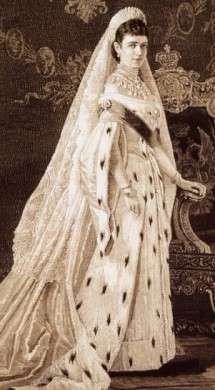Russian Fashion
Gdye mozhna koopit blue jeans?
—Flight of the Old Dog, by Dale Brown.
During the Cold War, the Soviet Union didn't really have much access to Western fashion, unless you were one of the nomenklatura or otherwise well connected.. This is why Sergei in the novel is surprised to see a woman wearing a denim jacket and jeans (he asks "Where did you get those blue jeans?"), gladly trading his coat for it.
Since the collapse though, Russian women (and men) have grabbed Western fashions voraciously. They are currently often found wearing several salaries on their person at once. In extreme cases, a driver's currently worn outfit can be worth more than his car.
This article, however, will focus on the items of clothing that are specifically Russian, or very common there. Note, that most 'traditional' items was outdated in USSR time or even earlier, and even in USSR times Russian fashion was heavily westernised.
- Bashlyk: A cone shaped hood of Cossack and Turkic origin. Associated with the early Reds with Rockets, but used before that by the Imperial Russian Military.
- Budyonnovka: Hat of the Reds with Rockets until the 1930s, like a kepi, but with a cone-shaped top. Associated with the Russian Civil War era and Communism, despite initially being designed for an Imperial WWI victory parade.
- Kaftan: For Russians, a long man's coat with tight sleeves. Now mostly worn by a sect of the Orthodox Church.
- Kokoshnik: A traditional female headdress, used with:
- Sarafan: a sleeveless jumper-dress. Mostly used now for folk dances, along with the previous item.
- Kosovorotka: A male Russian peasant's shirt. Not tucked in.
- A headscarf: worn by country women and older women in cities. A relic of the frozen in time Soviet fashion. Initially was a piece of clothing worn by religious mandate and symbolizing women's submission and modesty, similarly to modern Islamic headscarves; ironically, a red or scarlet headscarf was a typical headgear for female Commissars, Chekists or other strong, independent women aligned with Bolshevism in the Russian Civil War era.
- Telogreika: literally translated as "body warmer", a quilted short coat. The most common type of winter uniform until the 1960s was first issued by the Red Army during the Great Patriotic War. Very common in all media depicting the Eastern Front of the aforementioned war.
- Papakha: A wool hat (often made out of karakul sheep skin), associated with Georgia and Cossacks, sometimes worn by Tricolours With Rusting Rockets officers and generals.
- Telnyashka: A striped top, usually dark blue and white, worn by sailors and the VDV Airborne forces (they are the Russian equivalent of USMC, except they are paratroopers and not marines).
- Ushanka: The Russian hat. Made of fur with the ear flaps. Often worn by soldiers and cops during the long Russian winter. The army and police standard issue hat is made of cheap artificial fur; civilian hats are of natural fur and more expensive.
- Some have gotten to the US. Chief Marge Gunderson in Fargo is wearing one.
- Valenki (singular Valenok): Felt boots, used by the Soviet and Russian military during winter. Helped them win the Great Patriotic War, since their feet didn't freeze. Now have lost most of their popularity in cities.
- The military also continues to use jackboots for both ceremonial and field use, but in the latter case they are considered so uncomfortable that sneakers are often worn instead (probably because the standard Russian field jackboot is made of very heavy, stiff and generally uncomfortable type of cheap artificial leather called kirza; the ceremonial ones are better though). Regular combat boots are especially prized and are now gradually replacing jackboots from service (often being bought privately).
- Jackboots may be impractical in both garrison service and mountain warfare (the only kind of warfare The New Russia engaged itself in, to date), but they are the best thing there is in large-scale wars on wide open plains. That means, if someone invades Russia again, the boots will be useful.
- The military also continues to use jackboots for both ceremonial and field use, but in the latter case they are considered so uncomfortable that sneakers are often worn instead (probably because the standard Russian field jackboot is made of very heavy, stiff and generally uncomfortable type of cheap artificial leather called kirza; the ceremonial ones are better though). Regular combat boots are especially prized and are now gradually replacing jackboots from service (often being bought privately).
- Shinel (greatcoat). Russian military is one of the last ones still using greatcoats, since they are somewhat practical during winter. Attempts to introduce more high-tech, light, winterized uniforms so far resulted in pneumonias and frostbites.
- Big, high peaked caps are associated, among other things, with Russia, despite they are a new introduction to Russian uniforms. Smaller ones, though, have a long history in the Russian military, and a similar but even smaller civilian headgear, called kartuz, is indeed part of the traditional national costume.
